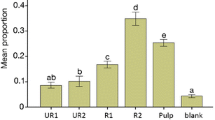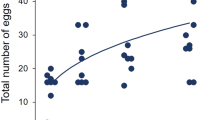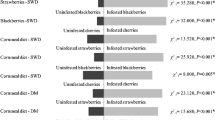Abstract
Mature oriental fruit fly females, Dacus dorsalis, from a population cultured on host fruit in the laboratory for one generation responded positively to visual and olfactory stimuli of individual natural kumquat (Fortunella japonica) and apple (Malus pumila) host fruit or models of these fruit hung from branches of potted trees in field enclosures. When females were exposed for 3 days to natural kumquats or apples on trees and subsequently released individually onto trees harboring one or the other of these fruit types, a significantly greater proportion of those exposed to kumquats than those exposed to apples or those not exposed to any fruit visited kumquats. Females exposed to kimquats for at least 3 days followed by at least 3 days of exposure to apples retained ability to find kumquats. Compared with females exposed to apples for 3 days or with naive females, females exposed to kumquats for 3 days exhibitied no less ability to find apples but did significantly refrain from accepting apples for oviposition. A final test was conducted in which females were exposed to natural kumquats or apples for 3 days and tested for response to inanimate models of either the same color and size as natural kumquats (orange, 20-mm diameter) or apples (green, 75-mm diameter) or models of the same color but opposite size. Results suggest that fruit size is the principal character learned and used in finding kumquats, which apparently are somewhat inconspicuous to an inexperienced foraging D. dorsalisfemale.
Similar content being viewed by others
References
Aluja, M. R. (1989).Interaction of Host Visual and Odor Stimuli During Intra- and Inter-Tree Host Finding Behavior of Rhagoletis pomonellaFlies, Ph.D. thesis, University of Massachusetts, Amherst.
Bernays, E. A., and Wrubel, R. P. (1985). Learning by grasshoppers: Association of colour and light intensity with food.Physiol. Entomol. 10: 359–369.
Dixon, W. J. (1985).BMDP Statistical Software Manual, University of California Press, Berkeley, pp. 330–344.
Guilford, T., and Dawkins, M. S. (1987). Search images not proven: a reappraisal of recent evidence.Anim. Behav. 35: 1838–1845.
Jaenike, J. (1988). Effects of early adult experience on host selection in insects: Some experimental and theoretical results.J. Insect Behav. 1: 3–15.
Kamil, A. C. (1988). Experimental design in ornithology. In Jonston, R. F. (ed.),Current Ornithology, Plenum, New York, pp. 313–346.
Kamm, J. A. (1989). In-flight assessment of host and non-host odors by alfalfa seed chalcid.Environ. Entomol. 18: 56–60.
Lee, J. C., Bernays, E. A., and Wrubel, R. P. (1987). Does learning play a role in host location and selection by grasshoppers? In Labeyrie, V., Fabres, G., and Lachaise, D. (eds.),Insects-Plants, Junk, Dordrecht, pp. 125–127.
Lewis, A. C., and Lipani, G. A. (1990). Learning and flower use in butterflies: Hypotheses from butterflies.Insect-Plant Interact. (in press).
Papaj, D. R. (1986a). Conditioning of leaf-shape discrimination by chemical cues in the butterfly,Battus philenor.Anim. Behav. 34: 1281–1288.
Papaj, D. R. (1986b). Leaf buds: a factor in host selection byBattus philenor butterflies.Ecol. Entomol. 11: 301–307.
Papaj, D. R., and Prokopy, R. J. (1989). Ecological and evolutionary aspects of learning in phytophagous insects.Annu. Rev. Entomol.34: 315–350.
Papaj, D. R., Opp, S. B., Prokopy, R. J., and Wong, T. T. Y. (1989). Cross-induction of fruit acceptance by the medflyCeratitis capitata: The role of fruit size and chemistry.J. Insect Behav. 2: 241–254.
Prokopy, R. J. (1968). Visual responses of apple maggot flies,Rhagoletis pomonella: orchard studies.Entomol. Exp. Appl. 11: 403–422.
Prokopy, R. J., and Fletcher, B. S. (1987). The role of adult learning in the acceptance of host fruit for egglaying by the Queensland fruit fly,Dacus tryoni.Entomol. Exp. Appl. 45: 259–263.
Prokopy, R. J., and Papaj, D. R. (1988). Learning of apple fruit biotypes by apple maggot flies.J. Insect. Behav. 1: 67–74.
Prokopy, R. J., Green, T. A., and Wong, T. T. Y. (1989a). Learning to find fruit inCeratitis capitata flies.Entomol. Exp. Appl. 53: 65–72.
Prokopy, R. J., Green, T. A., Olson, W. A., Vargas, R. I., Kanehisa, D., and Wong, T. T. Y. (1989b). Discrimination byDacus dorsalis females against larval-infested fruit.Fl. Entomol. 72: 319–323.
Rausher, M. D. (1978). Search image for leaf shape in a butterfly.Science 200: 1071–1073.
Siegel, S. (1956).Nonparametric Statistics for the Behavioral Sciences, McGraw-Hill, New York.
Swihart, C. A., and Swihart, S. L. (1970). Colour selection and learned feeding preferences in the butterflyHeliconicus charitonius. Anim. Behav.18: 60–64.
Traynier, R. M. M. (1987). Learning without neurosis in host finding and oviposition by the cabbage butterfly,Pieris rapae. In Labeyrie, V., Fabres, G., and Lachaise, D. (eds.),Insects-Plants, Junk, Dordrecht, pp. 243–247.
van Alphen, J. J. M., and Vet, L. E. M. (1986). An evolutionary approach to host finding and selection.Symp. R. Entomol. Soc. Land. 13: 23–61.
Visser, J. H., and Thiery, D. (1986). Effects of feeding experience on odour-conditioned anemotaxes of Colorado potato beetle.Entomol. Exp. Appl. 42: 198–200.
Author information
Authors and Affiliations
Rights and permissions
About this article
Cite this article
Prokopy, R.J., Green, T.A. & Vargas, R.I. Dacus dorsalis flies can learn to find and accept host fruit. J Insect Behav 3, 663–672 (1990). https://doi.org/10.1007/BF01052335
Issue Date:
DOI: https://doi.org/10.1007/BF01052335




